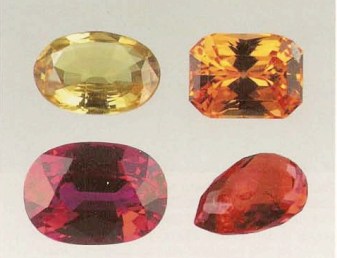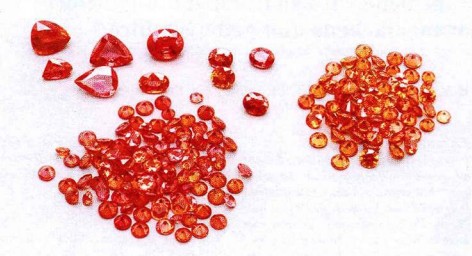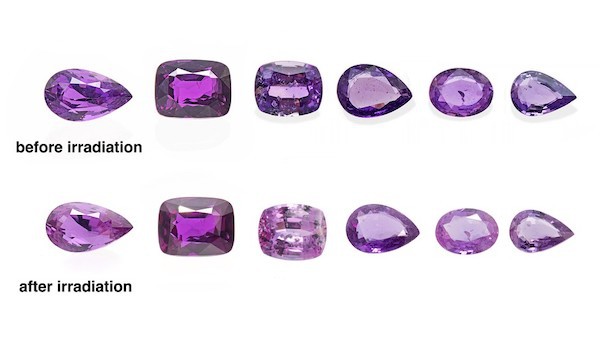
Effects of gamma irradiation on ruby and pink sapphire: an update
By Dr. Hao Wang, first published in Facette 29 (May 2024)
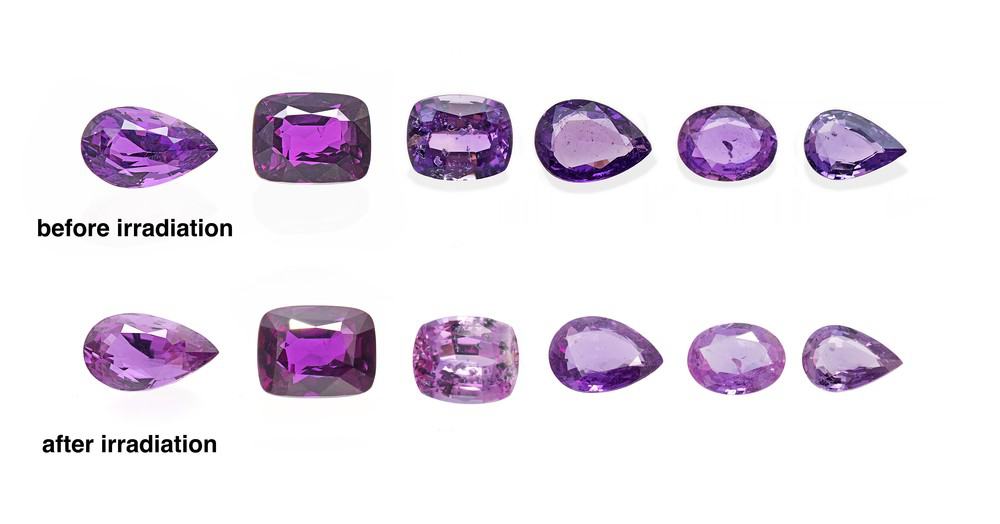
Gamma irradiation is a treatment method that may enhance the colour and visual appearance of gemstones, such as diamond, topaz, quartz, and corundum, to name a few. This treatment method uses strong gamma rays, either from radioactive isotopes like cobalt-60 (60Co) or from a linear accelerator (LINAC), to induce point defects in the crystal structure of gemstones. These defects, caused by the displacement or ionization of atoms, can lead to the creation and activation of so-called colour centres. This process can alter the gemstone’s colour in ways that range from subtle to dramatic, with the extent of the change depending on intrinsic properties of a gemstone (e.g. chemical composition and site occupancy) and the specifics of the irradiation process.
The exploration of gamma irradiation as a technique to enhance the colour of corundum dates back several decades. The advent of ruby lasers (synthetic, mostly of light colour and with pinkish hue) in the 1960s sparked extensive investigations in optical and material sciences into how gamma radiation affects these ruby lasers, especially its impact on their performance. In the 1980s, a keen interest appeared in the gem trade to experiment with gamma irradiation. The aim was to intensify the colour of yellow or pale gem-quality corundum and to bring these now more attractive irradiated stones to the market. It is thus safe to say that the irradiation of corundum is not a new treatment, but somehow remained mostly below the ‘radar’ of the gemmological community and the trade in the past decades, probably as the quantity of irradiated corundum was rather limited and mainly restricted to yellow sapphires.
The new so-called ‘hospital’ treatment
This has changed in the past few years, as we have multiple trustworthy sources which indicate that quite a number of rubies and fancy sapphires ranging in colour from pink to purple, light yellow and even blue may undergo an undisclosed gamma irradiation treatment before entering the marketplace (Figure 1). As this is a new challenge to the trade and labs alike, it initiated immediate research activities and discussions among gem labs with the aim to develop criteria to detect this irradiation treatment (Pardieu et al. 2022, Scarratt – pers. comm. 2022, Leelawatanasuk – pers. comm. 2022, Krzemnicki 2022, Krzemnicki 2023). Based on our information, this gamma irradiation treatment was originally carried out (secretly?) in medical facilities, utilizing cancer radiotherapy equipment, hence its name ‘hospital’ treatment. Based on more recent information, the treatment now is also carried out at non- medical irradiation facilities, mainly in countries known as cutting and trading hubs of corundum.
As mentioned above, the aim of this irradiation is to change and shift the initial colour to a more vivid and marketable one. Specifically, to remove the bluish hue in purple sapphires and rubies to end up with a vivid (‘hot’) pink or pure red colour, or to introduce an orange hue in pink sapphires, resulting in the best case in a pinkish orange colour as known for Padparadscha sapphire.
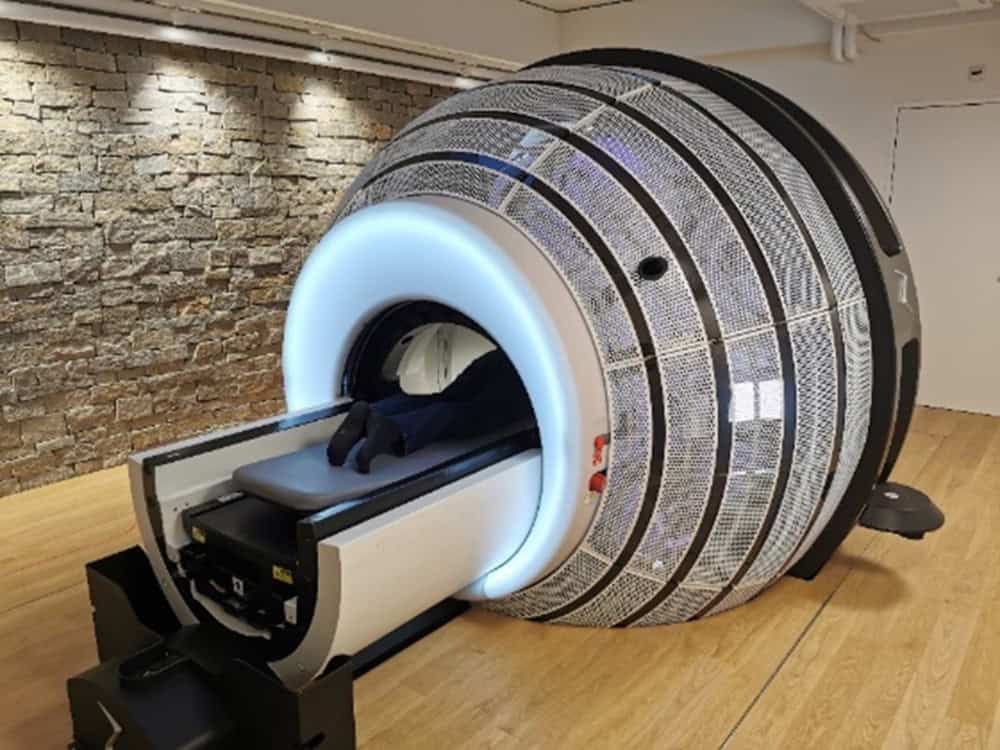
Irradiation experiments carried out by SSEF
Since 2022, the Swiss Gemmological Institute SSEF has been collaborating with the Swiss Neuro Radiosurgery Centre SNRC (Zurich) to better understand the effects of gamma irradiation on chromium-bearing corundum (rubies and pink sapphires) and to develop a testing method for detecting such irradiation treatment. In a series of experiments, corundum samples ranging from light pink (from Madagascar) to dark red colour (from Mozambique) were treated by gamma radiation using a LINAC instrument (ZAP-X, gyroscopic radiosurgery platform, USA) (Figure 2). This device features a well-defined 3D radiation profile and offers accurate radiation dose control. The samples were exposed to a total radiation dose of 10,000 Gray in increments of 2,000 Gray. Some of the samples were heated (1200°C for 10h) before gamma irradiation to eliminate any potential residual effects from previous treatments on the host gemstone and structurally ‘reset’ (anneal) any present zircon inclusion. The reason for this pre-treatment heating was to make the possible colour shift by gamma irradiation more pronounced and discernible. Following the irradiation experiments, immediate visual inspection was conducted. Various analytical methods, such as UV-VIS absorption spectroscopy of the corundum and Raman analysis of the zircon inclusions in pink sapphires were conducted to compare the results before and after gamma irradiation. To determine the colour stability of the irradiated gemstones, a standard stability test as well as a final annealing step (500°C) were applied.
In a second experiment run-up, we recently submitted a number of purplish sapphires from Madagascar anonymously to a facility for a so-called ‘hospital’ irradiation treatment (see Figure 1). These samples were kindly donated to SSEF by a supportive member of the trade. Again, all these samples were meticulously analysed at SSEF before and after irradiation. They are currently being inspected using further advanced analytical methods in collaboration with Swiss academic research institutions to fully document any changes which occurred by this treatment. This 2nd experiment is still an ongoing research study, which means that more detailed results of this experiment will only be presented in the near future.
Effect of irradiation on corundum: results of our experiments
Our experiments using the LINAC instrument reveals that gamma irradiation (at least with our chosen dose and experimental conditions) has no discernible effect on the colour of ruby of strong red saturation (from Mozambique). This is in line with results by other international research groups and labs. It may have, however, a certain influence on rubies of purplish hue and lower colour saturation as described by Suwanmanee et al. (2023), shifting their colour to a more attractive red hue.



Interestingly, while gamma irradiation altered the colour of the light pink sapphire significantly, it did not affect the structural integrity of the zircon inclusions to a measurable extent. In contrast to this, the heat treatment applied prior to gamma irradiation markedly decreased the FWHMs and RSDs of the zircon Raman peaks, suggesting a reduction in lattice disorder. These findings suggest that the dose of gamma radiation used in our study was insufficient to induce detectable changes in the zircon inclusions, contrary to expectations based on previous literature. Consequently, analysing zircon crystal disorder post-gamma irradiation may not currently serve as an effective method for detecting this irradiation treatment.
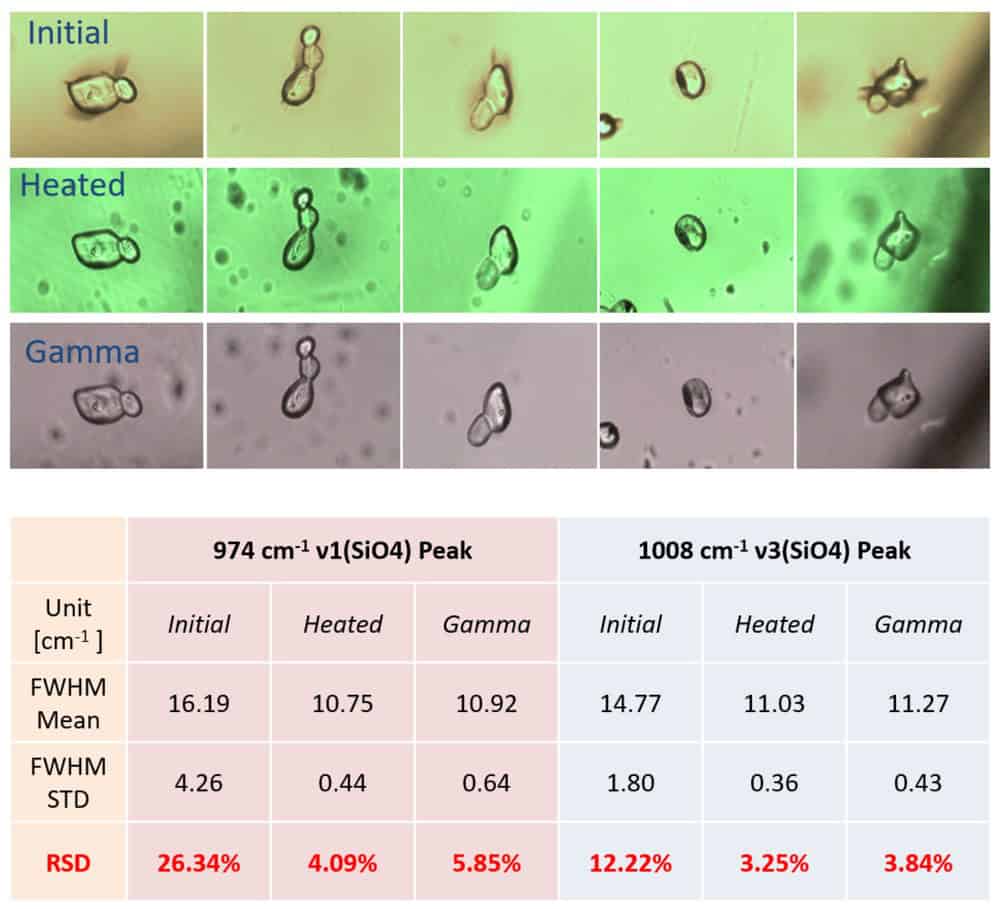
Outlook: what is to come?
Based on our current research results and after discussion with other gem labs, it has to be said that to this day, there is no criterion known which allows an unambiguous detection of gamma irradiation treated corundum.
Ongoing research at SSEF is focused among other things on exploring the relationship between the Cr-related photoluminescence (R-line intensity) and Cr-concentration, all with the aim to find a possible detection method for gamma-irradiated ruby and pink sapphires. It is essential to note that the detection of this irradiation treatment will likely require not only one criterion and detection method, but a combination of tests and methods, following the complexity of the effects of this treatment on corundum of different trace element composition and from different geological and geographical settings. This is even more true, as natural untreated corundum may have experienced natural irradiation if exposed to fluids containing radioactive elements or by natural irradiation in the host rock (Nassau and Valente 1987).
It currently is only possible to detect the treatment when the stone has also been analysed in its pre-treatment state and is compared and again analysed after irradiation. We know that this is a challenging situation for the trade and labs alike and would like to emphasize that we do the utmost in research trying to find solutions for the trade against this challenge and will update the trade regularly about any new findings in this matter.
References
Ashbuugh, C. E., 1988. Gemstone Irradiation and Radioactivity. Gems & Gemology 24, no. 4, 196-213.
Brown, I. J., and M. A. Brown, 1981. Low-Temperature Thermal Expansion of γ-Irradiated Ruby. Physical Review Letters 46, no. 13, 835-837.
De Goer, A. M., and B. Dreyfus, 1967. γ-Irradiation Effect on the Thermal Conductivity of Al2O3 with Cr or Mn Impurities at Low Temperature. Physica Status Solidi 22, no. 1, 77-82.
Dubinsky, E. V., J. Stone-Sundberg, and J. L. Emmett, 2020. A Quantitative Description of the Causes of Colour in Corundum. Gems & Gemology 56, no. 1, 2-28.
Flowers, W., and J. Jenney, 1963. Effects of γ-irradiation on the Performance of a Ruby Laser. Proceedings of the IEEE 51, no. 5, 858-859. Johnson, V.R., and R.W. Grow, 1964. Gamma Irradiation Effects in Ruby. Proceedings of the IEEE 52, no. 2, 185-186.
Johnson, V. R., and R. W. Grow, 1967. Effects of γ-Irradiation on the Performance of a Ruby Laser. IEEE Journal of Quantum Electronics QE-3, no. 1, 858-859.
Krzemnicki, M. S., 2022. New Additional Test at SSEF for The Colour Stability of Rubies SSEF Newsletter. https://www.ssef.ch/new- additional-test-at-ssef-for-the-colour-stability-of-rubies/
Krzemnicki, M. S., 2023. The Frontier of Research: Irradiation Experiments on Corundum. Facette no. 28, 40.
Maruyama, T., and Y. Matsuda, 1964. Colour Centers in γ-Irradiated Ruby. Journal of the Physical Society of Japan, no. 7, 1096-1104.
Nasdala, L., G. Irmer, D. Wolf, 1995. The degree of metamictization in zircon; a Raman spectroscopic study. European Journal of Mineralogy 7, no. 3, 471–478.
Nassau, K., 1983. The Physics and Chemistry of Colour. John Wiley & Sons Inc, New York.
Nassau, K., and G. K. Valente, 1987. The Seven Types of Yellow Sapphire and their Stability to Light. Gems & Gemology 23, no. 4, 222-231. Pardieu, V., K. Scarratt, R. Hughes, 2022. Irradiation of Rubies · A Cautionary Note. dated Feb. 23.
Powell, R. C., 1966. The Interaction of Chromium Ions in Ruby Crystals. Physical Sciences Research Papers, no. 299. Massachusetts: Office of Aerospace Research.
Zhu, W., L. Fan, and X. Lu, 2015. Structural evolution under gamma
ray irradiation of zircon originated from Hainan province, China. In Proceedings of the 3rd International Conference on Material, Mechanical and Manufacturing Engineering. Guangzhou, China: Atlantis Press, 1748-1752.
